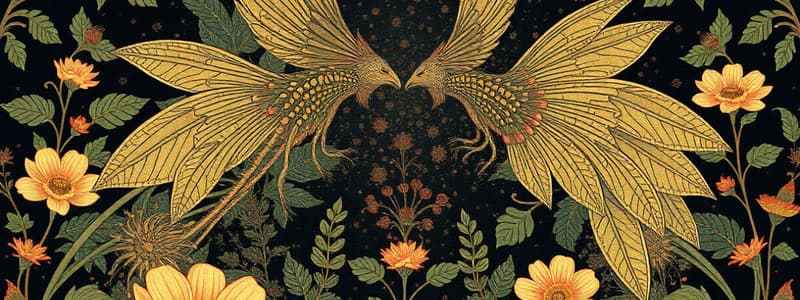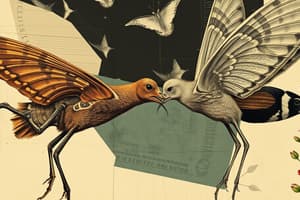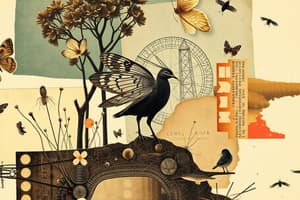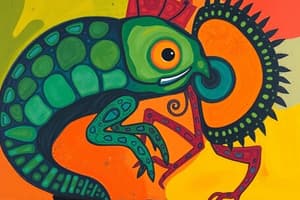Podcast
Questions and Answers
Which of the following best describes the fundamental importance of interactions between an organism and its environment?
Which of the following best describes the fundamental importance of interactions between an organism and its environment?
- It primarily determines the organism's physical size.
- It only affects the organism's reproductive capabilities.
- It dictates the organism's social behavior within its species.
- It ensures the organism's survival and the balanced functioning of an ecosystem. (correct)
Apparent competition is considered a direct form of competition between individuals because it involves physical altercations for resources.
Apparent competition is considered a direct form of competition between individuals because it involves physical altercations for resources.
False (B)
Briefly explain the difference between intraspecific and interspecific interactions.
Briefly explain the difference between intraspecific and interspecific interactions.
Intraspecific interactions occur between individuals of the same species, while interspecific interactions occur between individuals of different species.
The type of species interaction where both organisms benefit is known as ______.
The type of species interaction where both organisms benefit is known as ______.
Match the type of competition with its description:
Match the type of competition with its description:
Which of the following scenarios best illustrates intraspecific competition?
Which of the following scenarios best illustrates intraspecific competition?
Exploitative competition only occurs between different species, as it involves indirect resource depletion affecting multiple organisms.
Exploitative competition only occurs between different species, as it involves indirect resource depletion affecting multiple organisms.
Explain how an increase in a prey species' population (e.g., squirrels) can initially benefit another prey species (e.g., mice) but eventually lead to increased predation pressure on the latter in apparent competition.
Explain how an increase in a prey species' population (e.g., squirrels) can initially benefit another prey species (e.g., mice) but eventually lead to increased predation pressure on the latter in apparent competition.
In ____________ competition, organisms indirectly compete by reducing the availability of a shared resource.
In ____________ competition, organisms indirectly compete by reducing the availability of a shared resource.
Match the type of competition with its correct description:
Match the type of competition with its correct description:
Flashcards
Biological Interactions
Biological Interactions
Interactions between organisms in an ecological community.
Intraspecific Interaction
Intraspecific Interaction
Interaction between individuals of the SAME species.
Interspecific Interaction
Interspecific Interaction
Interaction between individuals of DIFFERENT species.
Competition
Competition
Signup and view all the flashcards
Interference Competition
Interference Competition
Signup and view all the flashcards
Intraspecific Competition
Intraspecific Competition
Signup and view all the flashcards
Interspecific Competition
Interspecific Competition
Signup and view all the flashcards
Exploitative Competition
Exploitative Competition
Signup and view all the flashcards
Apparent Competition
Apparent Competition
Signup and view all the flashcards
Indirect Intraspecific Competition
Indirect Intraspecific Competition
Signup and view all the flashcards
Study Notes
- Biological or species interactions are interactions between organisms in an ecological community within a defined geographic area.
- These interactions occur directly and indirectly, as no organism exists in isolation.
- The interaction between organisms and their environment is fundamental for survival and ecosystem balance.
- Species interactions are relationships between two species in an ecosystem.
- These interactions can be intraspecific or interspecific.
- Intraspecific interactions occur between individuals of the same species.
- Interspecific interactions occur between two or more different species.
Types of Species Interactions
- Competition
- Predation
- Symbiosis which includes:
- Mutualism
- Commensalism
- Parasitism
- Saprophytism
Competition
- Competition is a direct or indirect interaction where organisms sharing resources experience a change in fitness.
- The outcome often negatively affects weaker competitors.
- It is a detrimental interaction between individuals, populations, or rarely, clades.
- The three major forms are interference, exploitation, and apparent competition.
- Interference and exploitative competition are categorized as real competition, while apparent competition is not.
- Interference competition is direct, exploiting competition is indirect, and apparent competition also occurs indirectly between individuals.
Interference Competition
- This involves direct interaction by fighting for scarce resources.
- It applies to both intraspecific and interspecific competition.
- In intraspecific competition, organisms of the same species compete, such as aphids defending feeding sites and male deer locking horns.
- In interspecific competition, different species compete, like a lion and a tiger competing for the same prey.
Exploitative Competition
- This involves indirect interaction resulting from the depletion of resources.
- Exploitation competition applies to both intraspecific and interspecific competition.
- Intraspecific competition occurs when the same species compete for territory, mates, or food.
- An example is bears competing for food in the same area.
- Interspecific competition occurs when different species compete.
- An example is the competition for light between tall trees and smaller plants in a forest.
Apparent Competition
- A form of competition between species indirectly competing for resources.
- Occurs when species are prey for the same predator, such as hawks preying on both squirrels and mice.
- An increase in the squirrel population may initially benefit the mouse population but can lead to a higher hawk population, negatively affecting mice as the squirrel population declines.
- A decrease in the squirrel population can lead to a reduction in the mouse population if hawks seek out the more abundant mice.
- Apparent competition is difficult to identify in nature due to the complexity of indirect interactions.
Predation
- A biological interaction where one organism hunts and feeds on another.
- The predator hunts other organisms.
- The prey are the organisms being hunted.
- The predator relies on the prey as a food source.
- Their population levels are intimately entangled.
- Predator numbers decrease if the prey does.
- Predator numbers increase if the prey rises.
- Predators have adaptations to catch and consume prey, such as the hooked beaks and talons of raptors, sharp teeth and claws of mammals, quick speed, or venom.
- Prey have evolved mechanical, chemical, physical, or behavioral defenses.
- Mechanical defenses include armour such as turtle shells and bony plates.
- Chemical defenses involve producing or obtaining substances to prevent predation.
- Camouflage is a physical defence that involves body shape and coloration to avoid detection.
- Behavioral defenses include running, hiding, and playing dead.
Saprophytism
- The ability of certain plants to live in dead or decaying organic matter.
- Saprophytes live and feed on dead and decaying organisms.
- They are important in soil biology.
- Saprophytes break down complex organic matter into simpler substances for plants.
- Fungi and a few bacteria are saprophytes.
- Saprophytes produce filaments and lack leaves, roots, and stems.
- Saprophytes cannot perform photosynthesis, making them heterotrophic.
- They produce spores.
- Saprophytes secrete digestive juices and break down organic matter externally.
- The fungi grow hyphae to digest dead matter and secrete digestive substances to break down organic matter into simpler substances.
- Nutrients are absorbed directly through the cell membranes of the organisms.
Examples of Saprophytes
- Mucor: A saprophytic fungus that grows on decayed organic matter, especially those rich in carbohydrates, commonly found on stale bread, vegetables, and dung, and reproduces sexually and asexually.
- Yeast: Found on sugary substances, such as grape juice, flower nectar, and vineyards, and reproduces by budding under favorable conditions.
- Penicillium: Grows on decayed matter such as bread, jams, jellies, fruits, vegetables, and damp leather or shoes.
Studying That Suits You
Use AI to generate personalized quizzes and flashcards to suit your learning preferences.




